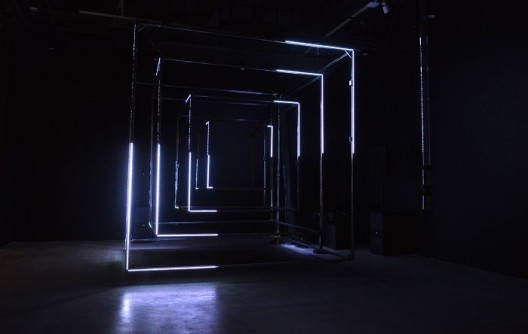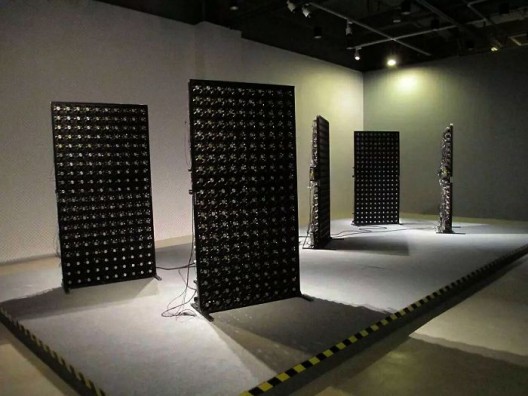Zheng Da and Lin Xin—”Post-Machine: Imagining HOLOS”
Wuhan K11 Art Village (Building #2, Central Business Street, Changqing Garden, Dong Xi Hu District, Wuhan) April 16-July 10, 2016
The exhibition preface describes “HOLOS” thus: “The wholeness of a collective intelligence of human, machines, and the natural world, and anything within this wholeness is holos.” This “Post-Machine” exhibition held at Wuhan K11 Art Village is not intended to demonstrate the possibilities for innovation brought on by technological development, but to highlight the relationship between humans and machines.
The “newness” in new media is no longer counteracts the oldness of traditional art. It has extended into such cutting-edge fields of science and technology as robotics, bioscience, and artificial intelligence. “Machine’s Free Speech” is an interactive LED installation constructed by Zheng Da and his team “Low-Tech Art Lab”. When face to face with this personified machine, electronic music is perhaps the sound of its heartbeat, while the patterns formed in the flashing LED might manifest its mode of speech. Here, the tempo and dynamics of music affect the LED. An interactive installation, the viewer can communicate with it through the metal sensor; that is, the machine can respond according to the person’s heart rate, which somewhat resembles how electrocardiograms are generated. Today, as science and technology are extensively applied to our everyday lives, technological media, as an auxiliary tool, acquires a natural existence through the social interaction. By way of huge nesting frameworks, Zheng Da enlarges the sense of technology being involved in our lives. Whether it is the order of the music being played or the flickering of the LED, all runs randomly. This “unpredictability”, to some extent, blurs sense of a subject behind the work, resulting in an effect of “autonomous speech” on the part of the machine.




Compared with “Machine’s Free Speech”, Lin Xin’s “The Order of Bugs Dimensions”comes across as considerably more “low-key”. By digitizing the exterior appearance of natural mineral crystal and adopting a self-written BUG code to remodel it, defects in the programming that are invisible to the naked eye are converted into visible images and renderings. To Lin’s mind, the imperfect BUG is the programming’s own distinctive character.. In these two artworks, a creative technique based on programming and coding seems to afford opportunity for “growth”. The artists forego design for the works’ ultimate effect, leaving them to run their own course.
“Physiological Reaction”aggregates 1200 PC cooling fans. By resorting to the fan blades’ dual status of stasis and motion, Zheng Da imbues his work with a detectable emotional reaction. We can feel the flow of air from the rotating fans, hear their buzzing sounds, and see untidy wires exposed behind the installation. No matter how it is designed, machinery ais emphasized as a product of industrialization. Conversely, in Lin Xin’s three-screen digital animation “Breezy Space”, machinery is personified to a degree that is easier to accept. The strength of the airflow in the virtual world is perceptible from the orderly disintegration of the robots’ bodies.
New media has gradually become a synonym for “higher level” artistic creation. Artists’ exploration within the field of technology is driven either by the search for a medium that is more in line with their creative ideas, or to break through a creative barrier using the “newness” of the medium. Both artists deem the medium to be the carrier of information—but it is not merely a simple tool. Zheng Da awakens a sensitivity that has faded thanks to the integration of technology into everyday life. Meanwhile, Lin Xin projects individual lives and sentiments onto the virtual world.



